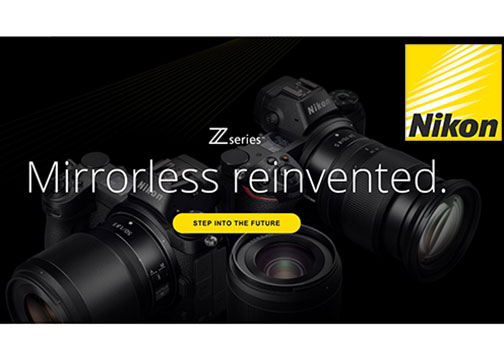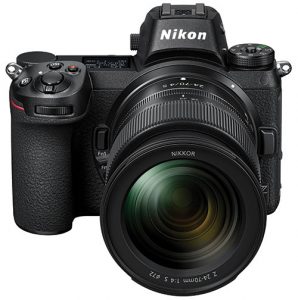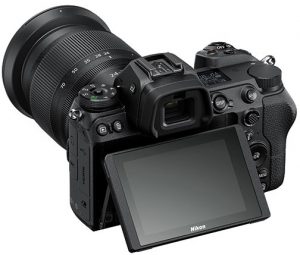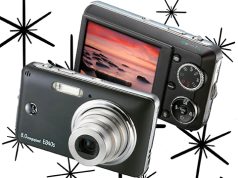
Melville, NY—Nikon Inc. unveiled the full-frame (Nikon FX–format) Nikon Z 7 and Nikon Z 6 mirrorless interchangeable-lens cameras, as well as Nikkor Z lenses. The system features a new, larger-diameter mount, to unlock further possibilities of lens design. The Z system will offer a variety of lenses, including the fastest lens in Nikon history, with f/0.95. In addition, a new mount adapter will enable the Z cameras’ compatibility with Nikkor F-mount lenses.

“This system has been realized through the pursuit of a new dimension in optical performance. It has inherited Nikon’s tradition of quality, superior imaging technology, intuitive operability and high reliability, all innovated from its digital SLR cameras,” the company announced.
“The letter “Z” represents the culmination of Nikon’s relentless pursuit of ultimate optical performance and a bridge to a new chapter. It is about redefining possibilities to provide image makers with tools to pursue greater creativity,” the company added.
The Z 7 and Z 6 employ a new backside-illuminated Nikon FX-format CMOS sensor with built-in focal-plane phase-detection AF (autofocus) pixels. The sensor works with Nikon’s latest image-processing engine, the Expeed 6. Together they provide high-speed continuous shooting at approximately 9 frames per sec (Z 7) and 12 fps (Z 6) to capture fast motion.
The high-resolution Z 7 boasts 45.7 effective megapixels and supports a standard sensitivity range of ISO 64–25,600. Moreover, sensitivity settings can extend from the equivalent of ISO 32 to that of ISO 102,400.

The Z 6 is an all-purpose FX-format camera with 24.5 effective megapixels. It supports a wide sensitivity range of ISO 100 to 51,200. This range can also extend from ISO 50 to the equivalent of ISO 204,800. In addition to high-sensitivity performance for low-light shooting, the camera boasts full-frame 4K UHD video capture with full pixel readout.
The two models share a familiar Nikon interface along with the benefits of a mirrorless camera, including hybrid autofocus, silent shooting and multimedia capabilities. The bodies are compact, with a firm grip. The sub-selector and buttons, such as AF-ON, ISO and exposure compensation, are placed so they can be operated swiftly. In addition, a display panel located on the top plate of the cameras displays information about settings, similar to high-end DSLRs.
Nikon Z 7 and Z 6 AF Key Features
The Z cameras employ a fast, accurate hybrid AF system. The Z 7 has 493 focus points while the Z 6 has 273 focus points. The AF system enables coverage of approximately 90% of the imaging area both horizontally and vertically. It also uses an algorithm optimized for the FX-format sensor, to automatically switch between focal-plane phase-detection AF and contrast-detect AF.
Moreover, the newly designed Nikkor Z lenses take full advantage of this system to provide faster, quieter and more accurate autofocus than previously possible for both still images and videos.

Another Z feature is a mid-range sharpening option that was added to picture control sharpness parameters. This option, along with existing sharpening and clarity parameters, allows users to make various textures within the screen sharper or softer—for stills and video. The cameras also offer 20 options of creative picture control.
Furthermore, Nikon says the electronic viewfinder adopted for the Z 7 and Z 6 “is comfortable and easy to use, comparable to optical viewfinders.” Both cameras are equipped with an EVF for which an approximately 3.69M-dot OLED panel was adopted. In addition, the EVF has frame coverage and magnification of approximately 100% and 0.8×, respectively. It also offers a 37° diagonal viewing angle.
Moreover, a fluorine coat applied to the EVF’s eyepiece protection window repels dirt. In addition, the <i> menu can be displayed in the electronic viewfinder. This allows users to quickly view and adjust various shooting settings, including ISO sensitivity, AF-area mode and picture control, while looking through the viewfinder.
Video Functionality and VR
Furthermore, the Z 7 and Z 6 support recording not only full-frame 4K UHD (3,8400×2,160)/30p movies using the FX-based video format, but they also record Full HD movies at 120p. Using the full-pixel readout, sharper 4K UHD movies are possible. In addition, active D-lighting, electronic vibration reduction (VR) and focus peaking can be used with 4K UHD and Full HD movie recording. Plus, an interval timer function makes 8K (Z 7) time-lapse movie creation possible.  Nikon’s original N-Log color profile can also be used with 10-bit HDMI output. The N-Log setting utilizes color depth and 12-stop, 1,300% dynamic range to record more tone information from highlights and shadows for effective color grading. Also, timecode support allows synchronizing video and sound from multiple devices. Additionally, the control ring built into Nikkor Z lenses can adjust settings such as aperture and exposure compensation.
Nikon’s original N-Log color profile can also be used with 10-bit HDMI output. The N-Log setting utilizes color depth and 12-stop, 1,300% dynamic range to record more tone information from highlights and shadows for effective color grading. Also, timecode support allows synchronizing video and sound from multiple devices. Additionally, the control ring built into Nikkor Z lenses can adjust settings such as aperture and exposure compensation.
Moreover, the Z 7 and Z 6 provide in-camera vibration reduction. The VR unit provides compensation for movement along five axes. The effects of vibration reduction are equivalent to five stops of shutter speed.
Other Z System Features
In addition, both cameras have a 3.2-inch, 2.10M-dot touch-sensitive LCD monitor with a tilting mechanism. Other features include: a peaking stack function that enables confirmation of the area in focus after shooting using focus shift; an extended low-light metering range to capture scenes like the transition from sunset to starry night sky using aperture-priority autoexposure; and SnapBridge with built-in Wi-Fi for direct connection to a smart device for content transfer.

The cameras also support existing DSLR accessories, such as the EN-EL15/a/b batteries, the optional WT-7/A/B/C wireless transmitter for transferring images/movies at high speed over a wired or wireless LAN; and radio-controlled/optical controlled wireless lighting for multi-flash photography.
Nikkor Z Lens
Nikon also announced three new lenses designed for the Nikon Z mount system’s full-frame mirrorless cameras. The standard zoom Nikkor Z 24–70mm f/4 S and wide-angle prime Nikkor Z 35mm f/1.8 S will be available September 27, 2018 for SRPs of $999.95 and $849.95, respectively.
The standard prime Nikkor Z 50mm f/1.8 S lens will be available in late October for $599.95. In addition, the Nikkor Z 58mm f/0.95 S Noct lens is in development.

Nikon additionally introduced the FTZ mount adapter for Z system compatibility with existing Nikkor F-mount lenses. It also will be available on September 27 and will retail for $249.95.
Moreover, the MB-N10 multi-power battery pack is currently in development. It will hold two EN-EL15b batteries to increase the number of shots possible and/or movie recording time by approximately 1.8×. It will also support USB charging using the EH-7P charging AC adapter.
The Nikon Z 7 will reach retail September 27, 2018 with a suggested retail price of $3,399.95 for the body-only configuration. It will retail for $3,999.95 as a kit with the new Nikkor Z 24–70 f/4 S lens.
The Nikon Z 6 will ship late November with an SRP of $1,995.95 body only. A kit with the Nikkor Z 24–70mm f/4 S lens will sell for $2,599.95.





